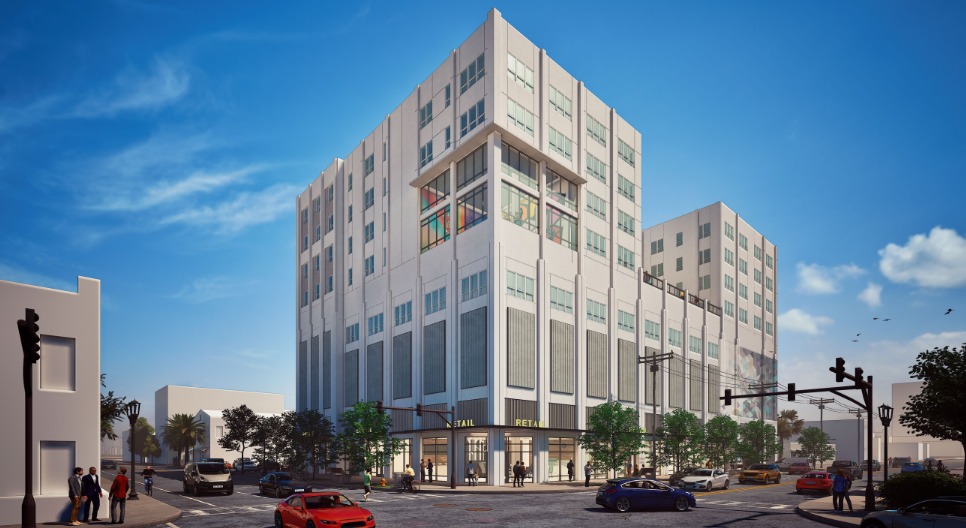Southbank self-storage, affordable housing project approved by Jacksonville City Council

A controversial project will bring self-storage to Jacksonville’s Southbank after over a year of community criticism and will receive a city loan for its affordable housing component, City Council decided Tuesday.
Council denied a previous version of the project last June, but the developer returned to the city with an altered proposal that also brought housing to the 10-story building on the corner of Hendricks Avenue and Prudential Drive.
Southbank and San Marco residents turned out en masse as the project went through the Downtown Development Review Board and council processes, but council ultimately approved it in a 11-8 vote.
“Why is the South Bank suddenly not the place that we want to have affordable housing?” council member Rory Diamond said before the vote Tuesday. “Every part of Jacksonville needs affordable housing, and we have to do it. In order to make it financially viable, you need something else that gives you revenue. That other thing in this case is self storage.”
The crux of the argument against the development centered on the four floors of self-storage units. The Downtown overlay in the Southbank allows all other aspects of the project, and residents continuously said it would negatively impact the area or create a “warehouse district.”
Proponents argued that without the units, the project bringing housing and retail to the empty corner would not happen – and the corner would potentially remain undeveloped for another decade.
Throughout arguments in City Council, there was the looming presence of the potential lawsuit the developer could file if the project was denied a second time. The city entered pre-trial mediation after the previous vote in order to avoid the suit.
The original project ended in a 9-9 vote in June, which the city said at the time constituted a denial. During mediation, the developer and city agreed to introduce legislation that could clarify that a tie vote did not have to be a denial, but instead send a bill back to committee. That legislation also passed in a 15-4 vote Tuesday.
The mediation agreement did not bind council to any particular decision, but council members defended it, saying the developers should not be punished for working with the community and the city.
“I support it because I want to reward neighbors who get involved in the development of their communities and reward developers who accommodate them,” council member Nick Howland said. “I think not doing so is a recipe for a disastrous development.”
What is included in the final development?

The DDRB staff recommended denial of the project, citing its opposition to the self-storage units, but the board ultimately approved it last week. It has still not approved a final design.
The building includes retail and restaurant space on the ground floor, one floor of parking, four floors of self-storage spaces and four floors of multi-family workforce housing.
The DDRB approval conditions mean that at least 8,500 sq. ft. of the ground floor will be dedicated to part retail and part restaurant space that does not include any space related to the self-storage or leasing office. The conditions also limit the storage operating hours from 6 a.m. to 10 p.m.
There will be 100 apartment units built by local developer Vestcor, with 75 reserved for households making at or below 60% of the area median income. Five units will be for those making at or below 120% AMI, and 20 units will not be income restricted.
Because of the housing component, the city also approved a $6 million low-interest loan for the project. The developer will pay 1% interest for 18 years, at which time the full amount will be due.
The city loan will cover what developers call “gap funding” in affordable housing projects, meaning the money missing to make a project financially feasible.
Joe Carlucci, the council member for the district, voted against the project and said in a committee meeting he wished it was purely housing. The necessary gap fund would have been lower, Carlucci said, if not for the construction costs of the self-storage unit floors.
Carlucci called the units an inefficient use of the valuable land and pointed to the already established zoning that would have allowed every other part of the project.
“It [the zoning change] is not creating anything,” Carlucci said. “...The current zoning is existing there today to allow the rest of this mixed-use development.”
Back to the drawing board: Controversial San Marco self-storage project zoning moves forward, design stalled
While some council members shared concerns over a lawsuit the developer could bring, Carlucci said the inverse was true: by passing the new zoning that could be inconsistent with the city’s comprehensive plan, the city could open itself up to lawsuits.
Matt Carlucci, the at-large district council member for the area, urged other members to vote against the project.
“There’s thousands of people who oppose this and they happen to have the benefit of being right. We’re going against the district councilmember and the at-large geographical member who have spent our lives in San Marco and the Southbank fighting for what’s best,” Matt Carlucci said.
The project design will return for DDRB approval in the coming months, but the plan will not be back to council.
This article originally appeared on Florida Times-Union: Southbank self-storage, affordable housing approved by City Council
